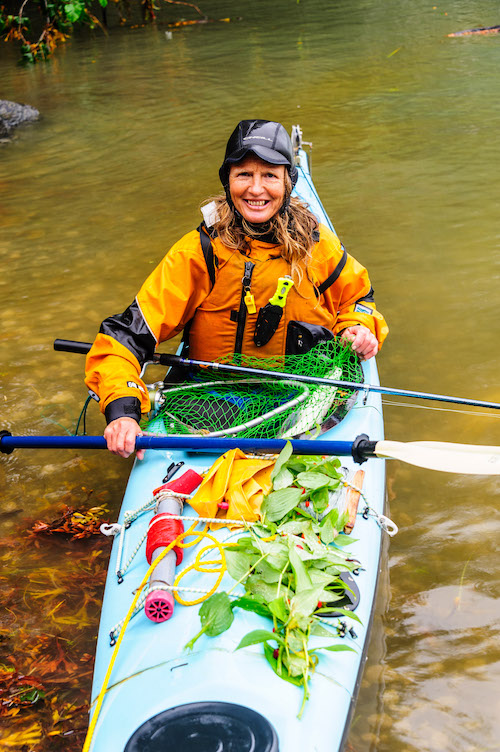This is the first installment of a series by Nancy Pfieffer and Fredrik Norrsell on their summer subsistence kayaking trip in Southeast Alaska. Stay tuned for more dispatches from the water.
With a variety of lightweight, compact, delicious, and easy to prepare camping foods available, why would a person choose to paddle around eating weeds?
At times I ask myself the same. Wilderness time is precious in our busy lives. Wouldn’t it be more enjoyable to go for a hike, than sit under a tarp picking through mounds of beach greens?
Nautical charts carpet the cabin floor. A home-built shrimp pot is nearly completed on the front porch. My husband Fredrik and I are within days of leaving for an entire summer of sea kayaking and eating wild foods. Our goal is not only to survive, but to thrive. Last August we lived simply, but well, for a month in Prince William Sound. It’s time to try a longer trip. With hope of dining on salmon, halibut and crab, we have chosen one of the world’s richest marine ecosystems, Southeast Alaska. However, seaweed, dandelions and limpets are also on the menu.

Photo: Fredrik Norrsell
These expeditions aren’t lightweight. The space we save on food is occupied by fishing gear, shrimp pots, collecting bags and a small fish smoker. Traveling like this isn’t less expensive. Compared to the cost of kayaks and paddling jackets, food is cheap and the things we do bring — spices, oil, condiments — add up quickly.
I relish the sweet illusion that by gathering my own food, this kind of life could go on forever. But summer will end. The colors will change. The bounty will disappear.
I do feel healthier on these trips. Outdoor exercise and a diet low in carbohydrates and sugars — closer to what our ancestors ate — make me feel more alive.
Mostly, we do this for what we learn. We pack a pile of reference books, but nature does the teaching. Those gulls, floating in a single file line across the mouth of the bay, know something we do not. An upwelling current is delivering breakfast. Maybe we should fish there as well. Searching for food makes us notice things in greater detail. Does that mushroom have true gills or flat-topped, diverging ridges? The initial excitement of finding a chanterelle mushroom in the woods is followed by the delight of finding a thick nest of the delectable little treasures, then a whole hillside.
After long Alaska winters surrounded by snow and ice, something within me craves the wild exuberance of summer. Watching a mosh pit of salmon bump and grind, crawling over each other for the opportunity to create future generations, catching a gorgeous silver salmon or finding a blueberry patch dripping with grape-size berries so heavy that branches sigh with the relief of being picked, puts me in awe of the earth’s abundance. Being surrounded by baby animals, catching a glimpse of a sea otter pup peeking out from its mothers arms, or a duo of humpback whales passing in unison, I feel a sense of much needed optimism for the earth. By eating wild foods we are intimately linked to the world around us in a fundamental way. And as Fredrik says, “There is something primal inside of us that longs to gather food.”
Feeling inspired by Nancy and Fredrik’s adventures? Explore kayaking destinations in our Paddling Trip Guide.




